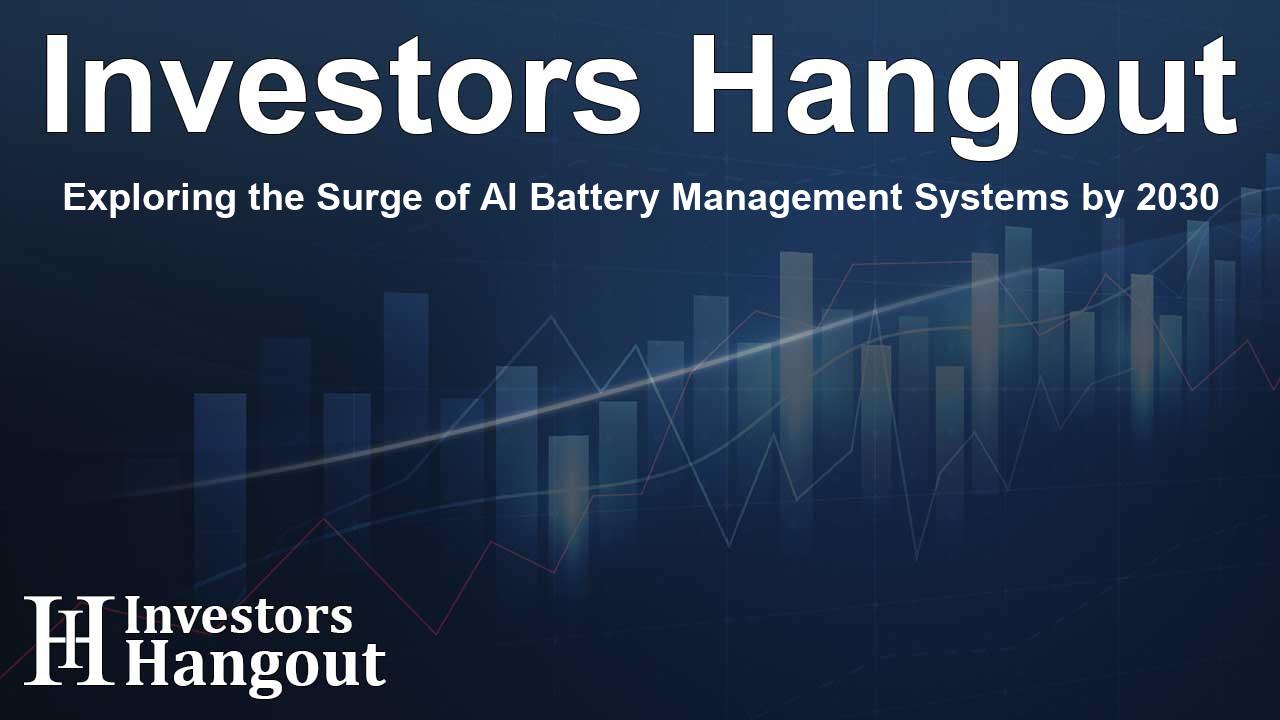Exploring the Surge of AI Battery Management Systems by 2030

The Rising Demand for AI in Battery Management Systems
The AI Battery Management System (BMS) market is experiencing an incredible surge as businesses and consumers alike recognize the critical role of advanced technologies in managing battery performance. With a projected market value of approximately USD 17.3 billion by the year 2030, up from an estimated USD 6.5 billion in 2023, the growth of AI BMS presents a significant opportunity across various sectors. The market is expected to grow at a compound annual growth rate (CAGR) of 15% during the forecast period. This promising trajectory underscores the importance of adopting sophisticated battery management solutions that keep pace with technological advancements.
Key Drivers of Market Growth
As the battery technology landscape evolves, companies are increasingly focused on developing tailored solutions that address diverse needs. Proactive battery asset management is now essential for maximizing efficiency and lifespan. The AI BMS market caters to this need by offering solutions that vary according to voltage needs and application requirements, which range from consumer electronics to large-scale power grids. Innovative partnerships and collaborations within the industry are accelerating the refinement of algorithms, safety features, and user interfaces.
Another key aspect driving growth in the AI BMS market is the rising popularity of electric vehicles (EVs). As the demand for EVs increases, integrating AI-driven BMS becomes crucial for ensuring reliable range, compliance with emission regulations, and fostering consumer trust. Energy storage operators, too, benefit from the predictive analytics offered by AI BMS, which enhances renewable energy output and instills stability in power grids. This multifaceted approach emphasizes the pivotal role of technology in achieving efficiency and sustainability in the energy sector.
Trends Shaping the AI BMS Landscape
The segmentation of AI BMS into low voltage (LV) and high voltage (HV) systems is a significant trend shaping its growth. LV BMS focuses on battery systems found in personal mobility devices, optimizing performance and enhancing lifespan through real-time data analysis. With consumers increasingly demanding efficient solutions for devices such as smartphones and e-scooters, LV BMS technologies are becoming indispensable.
On the other hand, HV BMS finds its application in electric vehicles, industrial applications, and grid-scale storage, where it efficiently manages the complexities of high-voltage systems. The ability to accurately monitor large battery packs under high loads allows for improved energy distribution and range maximization, responding decisively to regulatory pressures for cleaner energy solutions.
Automotive Applications Fueling Market Expansion
The automotive sector significantly influences the growth of AI BMS as manufacturers prioritize intelligent control and precise monitoring of battery packs in EVs. AI BMS ensures proper voltage balancing, extends battery life, and meets consumer expectations for quick charging. Additionally, by leveraging advanced analytics, automotive companies can detect potential issues early, thus reducing warranty claims and enhancing brand trust. For businesses, the data produced by AI BMS enhances decision-making related to route planning and maintenance schedules.
Government Initiatives and Electrification Trends
The global move toward electrification reinforces the demand for AI-based battery management systems as governments worldwide implement policies to promote EVs and renewable energy adoption. AI BMS technology addresses essential concerns like range anxiety in EVs, improving user experience through optimized battery usage. By streamlining charging and discharging cycles, AI BMS systems mitigate risks related to extreme operating conditions and enhance the reliability of renewable energy sources.
Embracing Emerging Battery Technologies
As engineers work on new battery chemistries to improve energy density and performance, AI BMS continues to evolve, adeptly managing complex battery architectures. The technology's capability to process intricate data allows for continual refinement of charging parameters according to each battery's unique characteristics.
Furthermore, industries increasingly rely on immediate feedback on battery health to maintain operational safety and efficiency. AI BMS directly addresses this need, facilitating real-time analysis of critical metrics such as current, voltage, and temperature. This proactive management helps reduce downtime and costs related to maintenance.
Safety Measures and Regulatory Compliance
The importance of safety cannot be overstated in the AI BMS market, particularly as stringent regulations push for enhanced safety standards. AI-powered systems excel at identifying potential hazards promptly, offering safeguards against short circuits and overheating. Implementing these advanced analytics allows companies to address issues before they escalate, ensuring compliance with international safety standards and mitigating liability risks.
While the initial costs of deploying advanced AI BMS solutions may seem high, the trend toward technological maturity leads to declining prices through mass production and efficient manufacturing processes. This phenomenon unlocks access for small and medium-sized enterprises, which can now leverage sophisticated tools that were previously available only to larger corporations.
Conclusion: The Future of AI BMS
As the AI BMS market continues to evolve and grow, it becomes increasingly pivotal in enabling advancements across diverse sectors. From enhancing energy efficiency to meeting regulatory compliance, AI BMS solutions facilitate smoother transitions toward a more sustainable future. The ongoing innovations in battery technology and management reflect a commitment to pushing the boundaries of what's possible, ensuring a brighter, more efficient energy landscape for everyone.
Frequently Asked Questions
What is the projected value of the AI BMS market?
The AI BMS market is projected to reach approximately USD 17.3 billion by 2030.
What factors are driving the growth of the AI BMS market?
Factors include increasing demand for electric vehicles, technological advancements, and a focus on energy efficiency.
How does AI technology enhance battery management?
AI technology improves battery management by providing real-time data analysis, optimizing charging cycles, and predicting failures.
In what sectors is AI BMS technology being integrated?
AI BMS technology is being integrated into sectors such as consumer electronics, automotive, and renewable energy.
How are safety measures improved with AI BMS?
AI BMS systems enhance safety by identifying potential hazards rapidly and ensuring compliance with safety regulations.
About The Author
Contact Caleb Price privately here. Or send an email with ATTN: Caleb Price as the subject to contact@investorshangout.com.
About Investors Hangout
Investors Hangout is a leading online stock forum for financial discussion and learning, offering a wide range of free tools and resources. It draws in traders of all levels, who exchange market knowledge, investigate trading tactics, and keep an eye on industry developments in real time. Featuring financial articles, stock message boards, quotes, charts, company profiles, and live news updates. Through cooperative learning and a wealth of informational resources, it helps users from novices creating their first portfolios to experts honing their techniques. Join Investors Hangout today: https://investorshangout.com/
The content of this article is based on factual, publicly available information and does not represent legal, financial, or investment advice. Investors Hangout does not offer financial advice, and the author is not a licensed financial advisor. Consult a qualified advisor before making any financial or investment decisions based on this article. This article should not be considered advice to purchase, sell, or hold any securities or other investments. If any of the material provided here is inaccurate, please contact us for corrections.
